Fauna and Flora of Cape Tribulation and the Daintree Rainforest
Flora
Palms
Daintree fan palm
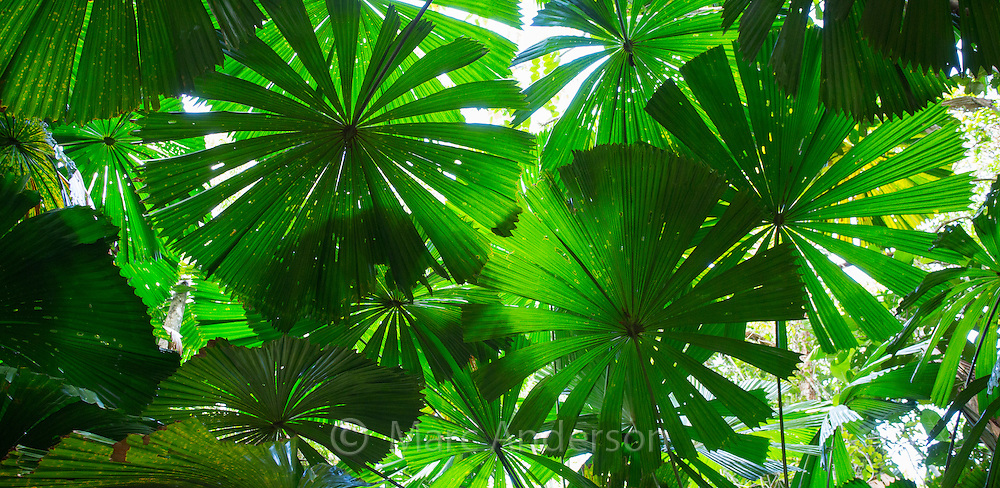 Commonly referred to as palm "trees", palms are not, strictly speaking, trees but monocot plants of the family Arecaceae. (Monocots (short for monocotyledon) plants are plants which have only one seed leaf, or cotyledon. Palms are recognisable by their straight, unbranched stems topped by large, evergreen leaves generally known as fronds. They are found in abundance in the Daintree rainforest and include fan palms and coconut palms. The coconut palm (Cocos nucifera) is a beautiful plant which is practically synonymous with "the tropics" in some people's mind. However, in Australia, it is an invasive weed species which has colonised Australian beaches by coconuts washing on to shore and has also been deliberately cultivated as an ornamental and food plant (and to save sailors). When it germinates on a beach, it quickly spreads and overruns native vegetation as fruits from the parent tree drop and germinate. (Coconuts germinate in three to six months)
Commonly referred to as palm "trees", palms are not, strictly speaking, trees but monocot plants of the family Arecaceae. (Monocots (short for monocotyledon) plants are plants which have only one seed leaf, or cotyledon. Palms are recognisable by their straight, unbranched stems topped by large, evergreen leaves generally known as fronds. They are found in abundance in the Daintree rainforest and include fan palms and coconut palms. The coconut palm (Cocos nucifera) is a beautiful plant which is practically synonymous with "the tropics" in some people's mind. However, in Australia, it is an invasive weed species which has colonised Australian beaches by coconuts washing on to shore and has also been deliberately cultivated as an ornamental and food plant (and to save sailors). When it germinates on a beach, it quickly spreads and overruns native vegetation as fruits from the parent tree drop and germinate. (Coconuts germinate in three to six months)
Cycads
Hope's cycad
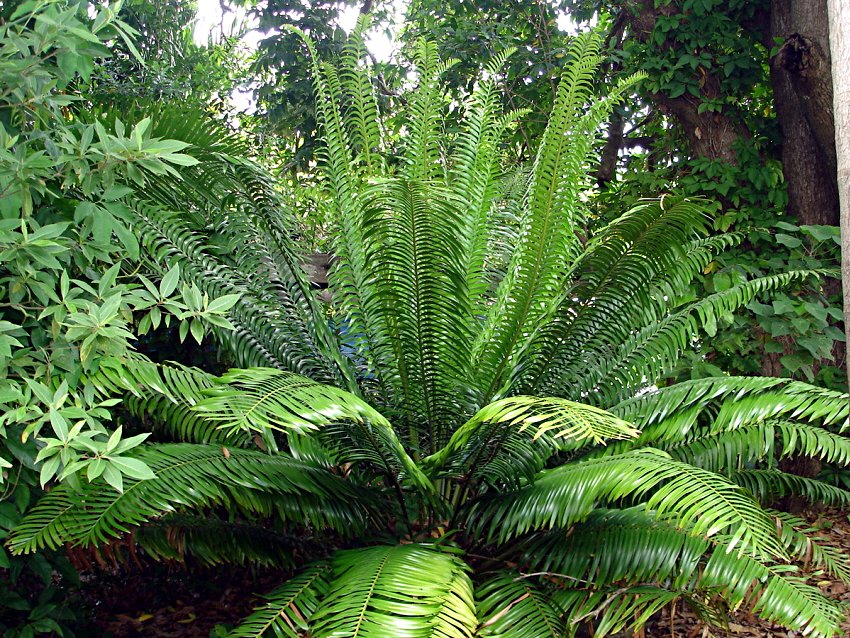 Cycads are large, gymnosperm (naked-seeded) plants of ancient origin and have changed little since the days of the dinosaurs. They have unbranched, cylindrical stems topped with large, fernlike leaves and are often mistaken for palms or ferns. There are at least three species of cycad in the Daintree rainforest: Bowenia (Bowenia spectabilis), Hope's Cycad (Lepidozamia hopei), and Cycas media.
Cycads are large, gymnosperm (naked-seeded) plants of ancient origin and have changed little since the days of the dinosaurs. They have unbranched, cylindrical stems topped with large, fernlike leaves and are often mistaken for palms or ferns. There are at least three species of cycad in the Daintree rainforest: Bowenia (Bowenia spectabilis), Hope's Cycad (Lepidozamia hopei), and Cycas media.
Conifers
Queensland kauri
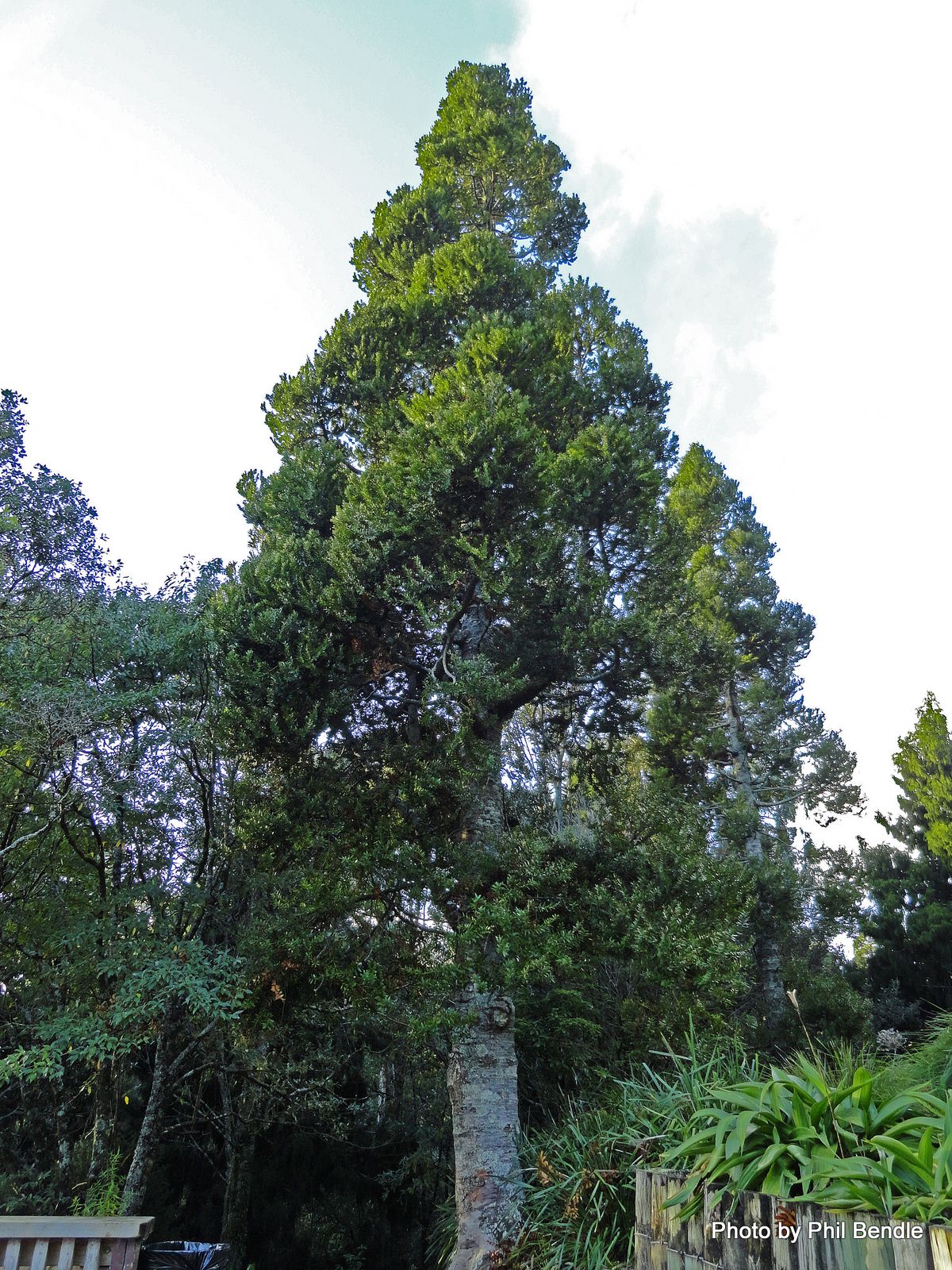 Most of the Daintree conifers, or pine trees are of the family Podocarpaceae or Araucariaceae. These include the brown pine (Podocarpus grayae), the rare Daintree pine (Gymnostoma australianum), which grows only between the Bloomfield River and Cape Tribulation - not a true pine, but a member of the family Casuarinaceae, or she-oaks, and two varieties of kauri, the Queensland kauri (Agathis robusta) and the bull kauri (Agathis microstachia). The kauris are huge - the biggest conifers in Australia. They are also primitive "living fossils" which have lived in this area almost unchanged since the Mesozoic era (roughly 250 million years ago to 65 million years ago). Species of kauri are distributed throughout the Pacific.
Most of the Daintree conifers, or pine trees are of the family Podocarpaceae or Araucariaceae. These include the brown pine (Podocarpus grayae), the rare Daintree pine (Gymnostoma australianum), which grows only between the Bloomfield River and Cape Tribulation - not a true pine, but a member of the family Casuarinaceae, or she-oaks, and two varieties of kauri, the Queensland kauri (Agathis robusta) and the bull kauri (Agathis microstachia). The kauris are huge - the biggest conifers in Australia. They are also primitive "living fossils" which have lived in this area almost unchanged since the Mesozoic era (roughly 250 million years ago to 65 million years ago). Species of kauri are distributed throughout the Pacific.
Fruit trees
Davidson's plum
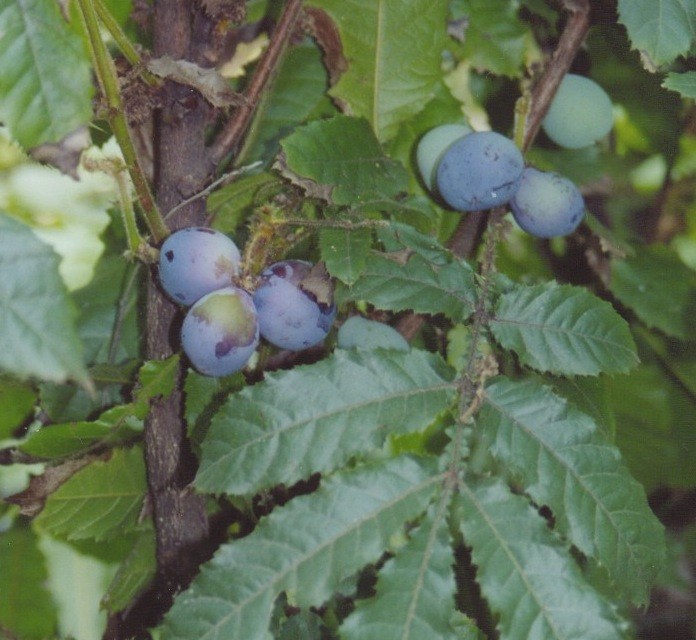 The Daintree rainforest offers a small variety of edible native fruits includin blue quandong (Elaeocarpus angustifolius (loved by flying foxes, various types of fig Davidson's plum (Davidsonia pruriens (not related to the European plum), and pandanus(Pandanus monticola - also known as scrub breadfruit).
As we don’t have monkeys - we have not developed “monkey-fruit” as have Africa, South America, and Asia.
Introduced fruit trees which are found in the Daintree area include soursop (Annona muricata),native to the Caribbean and Central America and related to the custard apple, durian )(Durio zibethinus) from southeast Asia, custard apple (Annona reticulata), a hybrid of the sugar apple and the cherimoya from South America, mango (Mangifera indica) from India, breadfruit (Artocarpus altilis), originally from the South Pacific but now cultivated in tropical areas all over the world, jackfruit Artocarpus heterophyllus, originally from India, and mangosteen (Garcinia mangostana) from the Sunda islands of Malaysia. Sadly - one of Florida’s most endangered trees (Annona glabra), or pond apple has become one of the most worrisome invasive trees of mangrove and riparian environments in Queensland.
The Daintree rainforest offers a small variety of edible native fruits includin blue quandong (Elaeocarpus angustifolius (loved by flying foxes, various types of fig Davidson's plum (Davidsonia pruriens (not related to the European plum), and pandanus(Pandanus monticola - also known as scrub breadfruit).
As we don’t have monkeys - we have not developed “monkey-fruit” as have Africa, South America, and Asia.
Introduced fruit trees which are found in the Daintree area include soursop (Annona muricata),native to the Caribbean and Central America and related to the custard apple, durian )(Durio zibethinus) from southeast Asia, custard apple (Annona reticulata), a hybrid of the sugar apple and the cherimoya from South America, mango (Mangifera indica) from India, breadfruit (Artocarpus altilis), originally from the South Pacific but now cultivated in tropical areas all over the world, jackfruit Artocarpus heterophyllus, originally from India, and mangosteen (Garcinia mangostana) from the Sunda islands of Malaysia. Sadly - one of Florida’s most endangered trees (Annona glabra), or pond apple has become one of the most worrisome invasive trees of mangrove and riparian environments in Queensland.
Deciduous trees
Cluster fig
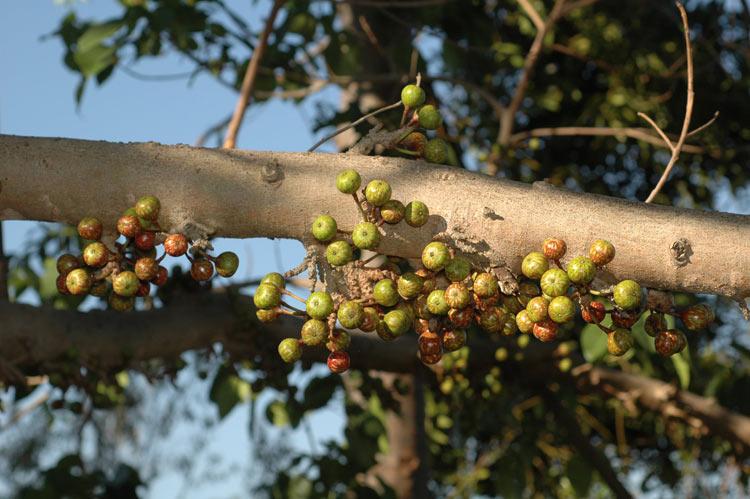 Australia as a whole has very few deciduous trees, and the Daintree rainforest is no exception. The three commonest species are the cluster fig (Ficus variegata and the so-called "dead horse tree" (Terminalia sericocarpa), and the red cedar (Toona ciliata var. australis).
Australia as a whole has very few deciduous trees, and the Daintree rainforest is no exception. The three commonest species are the cluster fig (Ficus variegata and the so-called "dead horse tree" (Terminalia sericocarpa), and the red cedar (Toona ciliata var. australis).
Native flowers
Purple ground orchid
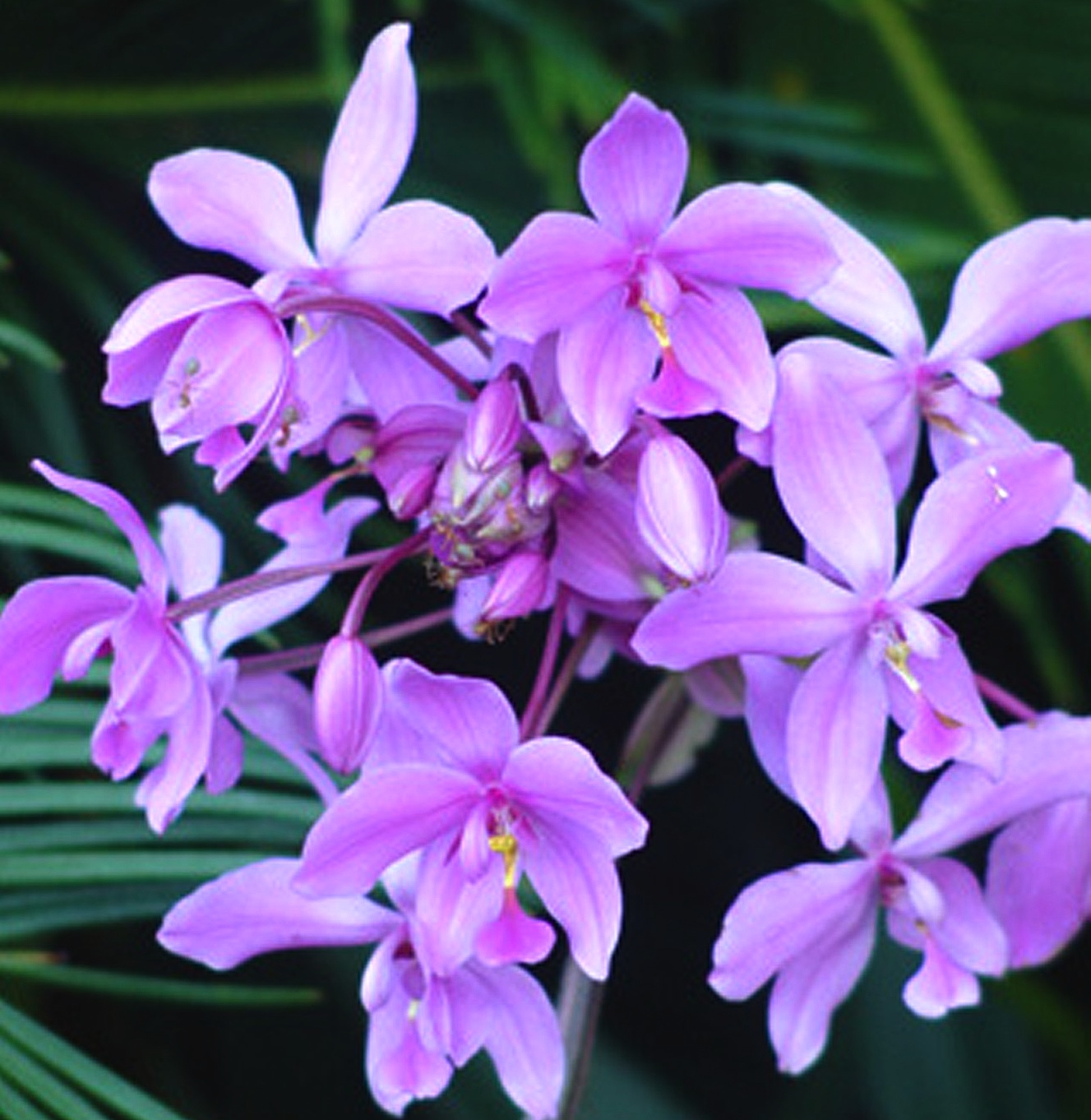 The Daintree rainforest has a wealth of native flowering plants and trees, including a greater assortment of primitive flowering plants than almost anywhere else on Earth. (New species are still being discovered, the most recent discovery being Geosiris australiensis, a very ancient species related to similar species in Madagascar and Mayotte). There is also the native hibiscus (Hibiscus heterophyllus), purple ground orchid (Spathoglottis plicata) and several other varieties of native orchid, and wheel-of-fire (Stenocarpus sinuatus), to name a few. (For more information about growing native Australian flowering plants and how to tell them from introduced weed species, see Grow Me Instead)
The Daintree rainforest has a wealth of native flowering plants and trees, including a greater assortment of primitive flowering plants than almost anywhere else on Earth. (New species are still being discovered, the most recent discovery being Geosiris australiensis, a very ancient species related to similar species in Madagascar and Mayotte). There is also the native hibiscus (Hibiscus heterophyllus), purple ground orchid (Spathoglottis plicata) and several other varieties of native orchid, and wheel-of-fire (Stenocarpus sinuatus), to name a few. (For more information about growing native Australian flowering plants and how to tell them from introduced weed species, see Grow Me Instead)
Introduced Weed Species
Singapore daisy
 Paradoxically, some of Australia's most beautiful flowering plants are also some of the most dangerous to its environment, especially to its native species because they are invasive, introduced weeds which, once they gain a foothold here, go feral and overrun or even kill their native competitors. (Some of these plants are allelopathic, meaning that they emit chemicals which are toxic to any other plant species in their vicinity.) Most invasivew weed species
were introduced as garden plants because they were particularly attractive or made good ground cover, but unfortunately, once here, they escaped the confines of their gardens, primarily by seed dispersal or, in the case of vinelike plants like Singapore daisy (Sphagneticola trilobata), by extending runners or even by regrowing from cut runners. Some notorious examples of invasive plant species in the Daintree area are (in addition to Singapore daisy): Arrow vine (Syngonium podophyllum), fishbone fern (Nephrolepis cordifolia), tropical kudzu (Pueria phaseoloides), and blue morning glory (Ipomea indica). For more information on invasive weed species and appropriate control methods, see the Austrop weed control page, and the Living in Daintree weed control page. (This page has links to a printable fact sheet and an interactive slide show on weeds.)
Paradoxically, some of Australia's most beautiful flowering plants are also some of the most dangerous to its environment, especially to its native species because they are invasive, introduced weeds which, once they gain a foothold here, go feral and overrun or even kill their native competitors. (Some of these plants are allelopathic, meaning that they emit chemicals which are toxic to any other plant species in their vicinity.) Most invasivew weed species
were introduced as garden plants because they were particularly attractive or made good ground cover, but unfortunately, once here, they escaped the confines of their gardens, primarily by seed dispersal or, in the case of vinelike plants like Singapore daisy (Sphagneticola trilobata), by extending runners or even by regrowing from cut runners. Some notorious examples of invasive plant species in the Daintree area are (in addition to Singapore daisy): Arrow vine (Syngonium podophyllum), fishbone fern (Nephrolepis cordifolia), tropical kudzu (Pueria phaseoloides), and blue morning glory (Ipomea indica). For more information on invasive weed species and appropriate control methods, see the Austrop weed control page, and the Living in Daintree weed control page. (This page has links to a printable fact sheet and an interactive slide show on weeds.)

